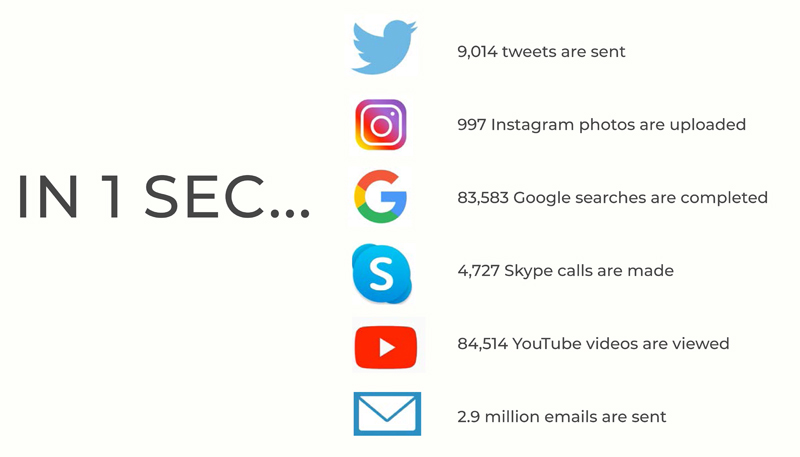15 Prepare, Pause, and Frame
Sarah Duffy
Get ready to focus and respectfully absorb as you prepare to develop a deep understanding of a source. Initiate connection and spark curiosity.
What You’ll Learn:
- Why engage actively
- How to prepare
- Why pause judgment
- How to quick check
Consider this: According to Internet Live Stats (2020), a site that tracks internet activity, in an average second:

Think about this: How does this volume of information impact our ability to focus, pay attention, and engage with a source long enough to get a deep understanding of it?
Engage Actively
Engaging actively with a source requires focus and attention. It involves creating space in your mind and your day to dive deeply into a source’s content and its message. It requires exploring the message’s nuances, creating connections to what you already know, and appreciating its context.
Passive and active engagement with a source look different. Active engagement takes time and effort, while passive engagement is faster and less focused. As professionals and students, it will be important to decide when active engagement is required.
How Are Active and Passive Engagement Different?
| ACTIVE ENGAGEMENT | PASSIVE ENGAGEMENT |
|---|---|
| Explore the context for the source. | Ignore the context. |
| Examine the purpose. | Engage without purpose. |
| Alter your speed based on the significance and difficulty of the source. | Use the same speed for all sources. |
| Preview before engaging. | Don’t preview; just jump right in. |
| Engage with questions in mind. | Engage without questions in mind. |
| Stop to monitor your understanding. | Don’t stop to think about whether you are understanding. |
| Annotate if reading; read with a pencil or highlighter in hand to mark important passages and jot down notes. | Don’t annotate. Don’t have anything in hand. |
| Make time to reflect upon and evaluate the source. | Don’t make time to reflect upon and evaluate the source. |
Prepare
This first step of engaging actively is about knowing yourself as a reader and finding a space that works for you, away from distractions. If possible, this space should also be a comfortable working environment. Physical discomfort can also interfere with your ability to focus.
For example, you might know that if you sit in a common area, you will be distracted by your roommates and their actions, getting side-tracked and involved in their activities rather than focusing on the source. Or having your phone at your fingertips with alerts buzzing and beeping will lure you onto social media and its enticing diversions.
Along with finding a good physical space, you should also give some thought to the time of day, and your fatigue and energy levels. You probably have a window of time in the day that is most productive for you. Perhaps it’s first thing in the morning when you’re the only one up and your place is quiet. Find that time and use it for tasks that require focus and attention. Put away distractions and set a timer; be prepared to focus for a planned amount of time.

According to an article titled “8 Ways to Improve Your Focus” on fastcompany.com, “If it’s too hot or too cool in your work environment, it could impact your focus. A study from Cornell University found that workers are most productive and make fewer errors in an environment that is somewhere between 68 and 77 degrees [20 and 25 degrees Celsius]. Another study from the Helsinki University of Technology in Finland says the magic temperature is 71 degrees [22 degrees Celsius]. If you don’t control the thermostat, you can opt to bring a sweater or a fan” (Vozza, 2015, para. 12).
Pause Judgment

In our polarized world where people have strong positions on many topics, it can be easy to get caught up in offering opinions. You may navigate frequently through social media, posting and commenting, perhaps positively, perhaps negatively, since, in the digital world, opinions flow quickly and easily. The anonymity and protection of a screen contribute to this.
It is important at times, and especially for professional or academic purposes, to pause. Pause so that you can give quiet and respectful consideration to others’ viewpoints. Pause so that you can develop your own considered, evidence-based response that builds from your understanding, finds common ground, and, when relevant, disagrees constructively
In this first stage of absorbing a source, you should practise pausing. Wait to hear and understand. Later, you will respond, analyze, and critique.
Quick Check
Ok, now that you’re comfortable, ready to focus, and have paused judgment, you should do one more thing before you start to work with a source: a quick check to frame it. This creates context for understanding and further investigation later. Be inquisitive about the source. Learn a little about it—who is the author? When was it written? Where was it published? What can we predict and learn from the title? This is a time when you might be reminded of how much you love your smartphone because all these answers are at your fingertips. Don’t spend too long on this; a quick internet search should be enough.
QUICK CHECK:
“It’s Time for ‘They.’” Read it here.
Publication Name and Details
“It’s Time for ‘They’” was published in The New York Times. If you don’t know anything about The New York Times as a publication, you could take another few moments to learn more. You’ll learn that it’s an American publication. On first glance, does it seem to be a credible source? Why or why not? These are the sorts of questions you might want to consider quickly, but you will return to explore them further later.
Publication Date
“It’s Time for ‘They’” was published in 2019.
Prediction from Title
The title of this article seems fairly clear. You might expect to read about the word “they,” and given the use of “It’s Time for…,” you might predict that the author is expressing a strongly held opinion in this article.
Author Details
You can also do a quick internet search on the author, Farhad Manjoo. You’ll learn that they have been a columnist at The New York Times since 2018. What else? They were born in South Africa and have been a journalist at other publications since 2008.
A quick check should take you no more than 3–5 minutes. Don’t spend more time on it. The benefit of framing a source is that you’ve begun your journey of engaging with the source, becoming curious about what you will read, and building respectful understanding.
Try It!
Do Your Own Quick Check
Directions:
- Complete a quick check for “Forgiveness Story” by June Callwood in the table provided. Access “Forgiveness Story” here.
- Compare your quick check to the model.
In this subtopic, you’ve learned the first steps of actively engaging with a source including how to
- prepare to engage with a source;
- pause judgment to allow understanding; and
- quick check a source’s background.
References
See Prepare, Pause, and Frame References
A subtle meaning, or meaning that is present but not immediately obvious until closer inspection.
The background situation or larger ground within which something is situated.
Division into extremely different views by groups or parts of the population.
Productively, with good will and the intention to cooperate. When you disagree constructively, you show respect for and understanding of whomever you’re disagreeing with.
Judge or evaluate a source.
Curious, questioning, wanting to discover more.
Another term for contextualizing, i.e., understanding the background of the source in question.

